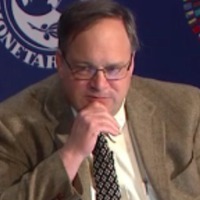Discounting the Future: Financial Markets, Memory, & the Mirage of ‘Normal’
Secular Stagnation in Occlusion, Yet Global Savings Glut Still in the Foreground: With Fed policy frozen for at least the summer, the monetary muddle continues: Today’s discount rates reveal the real anxieties haunting global finance, while the Fed’s dot plots reveal a split committee, and hence one that has to be modeled not as a rational but as a confused actor…
Remember when the future was really cheap? The market’s discounting of long-term value has quietly shifted, exposing deep uncertainties about growth, savings, and the persistence of chaos-monkey governance. The market’s real interest rate calculus has changed. The “normal” macroeconomic world of the 1990s is a fading memory, replaced by a regime where the future is more valuable, but hardly secure—still haunted by the global savings glut, if not full-blown secular stagnation, with policy uncertainty never far from the stage.
Across my screen comes the very sharp Tim Duy, who writes:
Tim Duy: Fed Watch, 6/18/25 <https://public.hey.com/p/5gobQ2gmfq4owmTHRvNSgCcY>: ‘The path to a [Federal Reserve] rate cut begins with inflation coming in below expectations [of 0.3%-points per month] over the summer, which means that tariffs are absorbed in the economy somewhere other than in consumer prices, or that service sector disinflation compensates for tariffs. There is a lot of data between now and September. The Fed’s not going to know what it’s doing until it gets its hands on that data.…
The SEP projections for 2026 and 2027 show slightly more persistent inflation than previously expected. This is, perhaps, a nod to the structural forces—demographics, deglobalization, fiscal expansion—that have made the post-plague world so challenging for central bankers.
And Tim Duy notes that the Federal Reserve is now substantially and evenly split. Barkin, Hammack, Kugler, Logan, Musalem, Schmid, and Williams are expecting and hoping to hold interest rates constant throughout the rest of 2025. Bostic and Kashkari are pencilling in one 25%-point rate cut. Barr, Collins, Cook, Daly, Goolsbee, Harker, Jefferson, and Powell are pencilling in two cuts. And Bowman and Waller believe an 0.75%-point rate cut before January would be appropriate.
For the no-big-shock longer run, the hawks see the neutral Fed Funds rate that is the economy’s aggregate demand-supply balance point as still at something like 3.75%/year; the doves see it as 2.75%. (With the current 3-Month Treasury-Bill rate at 4.2%/year and the 10-Year Bond rate at 4.4%/year; and trailing-year CPI core inflation at 2.75%/year.)
With a confused and evenly split FOMC, the Fed’s stance is firmly “wait and see.” Summer inflation news, primarily driven by the evolving impact of Trump chaos-monkey tariff governance, ought to be decisive. Then again, history teaches us that “the next six months will probably be decisive” is more often than not an unhelpful cl=op-out.

